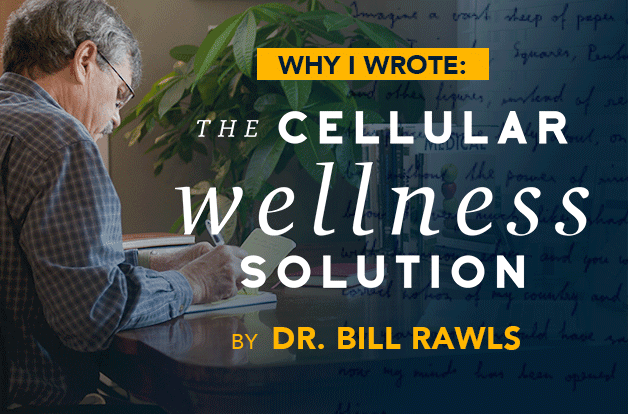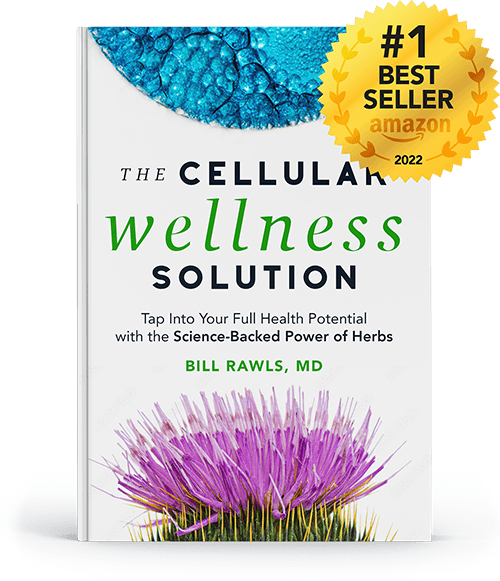With the recent launch of The Cellular Wellness Solution, I’m overjoyed at the positive responses the book has received from enthusiastic readers all over the country — those who’ve remained with me through the years and those who are venturing into herbal therapy for the very first time. I’m genuinely grateful to be a part of your health journey.
With that said, my goal in writing The Cellular Wellness Solution was to provide you with knowledge that has the power to transform your health and teach you how to minimize symptoms throughout life, reduce your risk of illness, and slow the aging process.
You Can Be Well and Stay Well
That may sound like a bold statement, but I truly believe that good health is not as impossibly complex as the healthcare system has made it out to be.
You can be well and stay well – through simple, sustainable lifestyle changes that protect, fuel, and nourish your body’s countless cells and their critical processes. In this book, I teach you how and provide you with the roadmap I follow for my own cellular health and wellness.

Some of you may have read my previous book, Unlocking Lyme, which detailed my journey with chronic Lyme disease. While I am honored by the tremendous reach that book has had and the lives that were changed, I want to be clear that this book is not about recovering from Lyme disease. Instead, The Cellular Wellness Solution presents life-changing information for individuals at all levels of health.
Overcoming chronic Lyme disease carried me to a new place and led me to connect dots in unique ways. They say that adversity makes you stronger, and that has certainly been true in my case. It led me to make two discoveries that have changed my life.

DISCOVERY #1: The enormous role that microbes play in accelerating illness and aging and why they are the biggest “little” threat to your health as you age:
I’ve been a part of the conventional medical system for 35 years, yet microbes have only become part of the discussion in the past five years. Only recently have we even acknowledged the role of the gut microbiome, yet we have microbes in all the tissues in our bodies, and they play an enormous role in our health.
My unique experience with chronic Lyme opened my eyes. It is now clear to me that microbes are a hugely important factor in illness, but we haven’t been paying attention. Microbes are deeply embedded in all systems of our body, and study upon study is now coming out to prove it. They drive our health: how we feel, what symptoms we experience, and what illnesses we may get.
Global crises such as COVID-19 are putting this on our radar, but this is just the start. I believe we are on the edge of a revolution in the way we think about microbes. Studies from the past five years that link microbes to Alzheimer’s, cancer, Parkinson’s, and other illnesses are some of the most promising that I have seen in my career as a physician.
It is fascinating science — and it has the potential to revolutionize the way we think about our health and approach to illness. In The Cellular Wellness Solution, we walk through this game-changing information that will forever shift how you think about your health.

DISCOVERY #2: The incredible health-boosting power of herbs and wild plants, plus why it is the solution to better health:
My journey in overcoming illness led me to understand the vital role that plant chemicals — called phytochemicals — serve in protecting our health. Phytochemicals (primarily from herbal therapy) led me back to a vibrant, symptom-free life without dependence on drugs, a state I wasn’t sure I’d ever regain.
The importance of phytochemicals was exempt from my 35 years as a physician. Over the past 100 years, we have lost touch with herbs and wild plants as a society, and they are now totally missing from our modern medical toolbox. Herbs, which were once honored as medicines, are seen as ineffective by many physicians.
I am grateful for my years of struggle with chronic illness because it led me to discover herbs, which has forever changed my life.
While I don’t preach any one “miracle cure,” my personal experience with herbal therapy was truly remarkable, and herbs have become an essential part of my wellness toolbox. While my regimen has changed over the years, I still take herbs every day and will continue to for the rest of my life. They are the cornerstone of my strategy to age well, support my cells, and reduce my risk of illness.
Phytochemicals, especially those from herbs and wild plants, are critical for protecting against factors of illness — including microbes, which, as shared above, are a significant driver of illness and symptoms. I’ve come to realize how hugely important they are, and yet, most people I talk to are overlooking herbs. They don’t understand them, why to take them, or even where to start.
Phytochemicals from herbs and wild plants are the biggest piece of the puzzle I see people missing in their pursuit of optimal health and wellness. We’ve lost a vital connection with plants as we’ve shifted to a modern lifestyle.
In this book, I detail how to get herbs and plant power back — without giving up the conveniences and extraordinary benefits of your modern life. By leveraging plant intelligence and bringing powerful phytochemical benefits into your everyday life, alongside a healthy, sustainable lifestyle, you can achieve wellness.
The Path to Better Health
As promised above, I believe there are simple, sustainable lifestyle changes you can make that will have an enormous impact on your health moving forward.
The second half of my book is dedicated to providing you with a roadmap, including more than 500 pages of actionable recommendations. I show you where to start with herbs and how to make them a part of your lifestyle. Whether you choose to follow my plan in full or make it your own, my goal is to present steps that you can start taking. It is not an all-or-nothing approach. I believe that any small change can make a big difference, and often, that’s the approach that sticks long term.
I believe that if everyone in our society made these simple changes and started taking daily herbs, we could cut our rate of chronic illness in half within five years. That is how powerful these simple concepts are. I know that is a lofty goal, but my aim with this book is to influence as many people as possible.
Change Starts with You
No matter where you are in your health journey, this book offers actionable solutions that can revolutionize your life. While I do not preach miracle solutions, I believe good health is within reach for anyone who is committed.
If you are committed to making good health habits a part of your life, The Cellular Wellness Solution has the power to alter your future and offer the freedom you’ve been searching for to live a more vibrant life.
 Discover more in Dr. Bill Rawls’ new #1 Bestselling book: The Cellular Wellness Solution: Tap Into Your Full Health Potential with the Science-Backed Power of Herbs.
Discover more in Dr. Bill Rawls’ new #1 Bestselling book: The Cellular Wellness Solution: Tap Into Your Full Health Potential with the Science-Backed Power of Herbs.
“An eye-opening and empowering book that the world needs right now: The Cellular Wellness Solution will fundamentally change how you think about herbs and the powerful role they play in cultivating wellness at the cellular level.”

Mark Hyman, MD
Fourteen-time #1 New York Times Bestselling Author
Looking for More Wellness Tips?
Join our newsletter for bi-weekly tools, education, and savings to boost your health.



